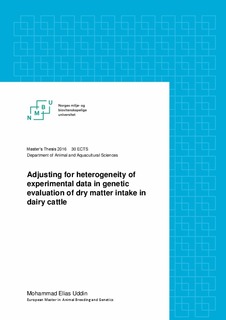| dc.description.abstract | Feed cost is the major cost for dairying. So, improving feed efficiency could make dairy farming economically more profitable and environmentally viable by reducing methane emission. But, measuring feed intake in dairy animals is not only difficult but also expensive. So, feed efficiency traits were not considered in the dairy breeding program in past decades. One of the solutions of this problem might be the use of feed intake data from nutritional experiments. The objectives of the present study were i) to find the best fitted model for repeatedly measured daily dry matter intake (DMI) data obtained from different herds and experiments across lactations and ii) to get better estimates of the genetic parameters and better genetic evaluations. After editing, there were 572512 daily DMI records of 3495 animals from 11 different herds across 13 lactations and animals were under 110 different nutritional experiments. The fitted model for this dataset was a univariate repeated measure animal model in which additive genetic and permanent environmental (within and across lactations) effects were fitted as random. Two different models were fitted based on different fixed effects. For unscaled data, each model was fitted as homoscedastic (HOM) model at first and then heteroscedastic (HET) model. After that, data were scaled by multiplying with particular herd’s scaling factors which were calculated by accounting for heterogeneity of phenotypic within herd variances. Models were selected based on cross-validation and prediction accuracy results. Scaling factors were re-estimated to see the effectiveness of accounting herd heterogeneity. Variance components and respective heritability and repeatability were estimated based on pedigree based relationship matrix. Spearman’s rank correlations of EBVs between scaled and unscaled DMI were also calculated. All the analyses were performed using ASReml software package. Results indicated that HOM model for scaled data showed better fit than the models (HOM or HET) fitted for unscaled data. The heritability and repeatability estimates of daily DMI for the final model (HOM model 3 fitted for scaled data) were 0.08 and 0.51, respectively. The re-estimated scaling factor after accounting for heterogeneity of residual variances was close to 1.0 indicating the stabilization of residual variances and herd accounted for most of the heterogeneity. The rank correlation of estimated breeding values (EBVs) between scaled and unscaled data ranged from 0.96 to 0.97. | nb_NO |
